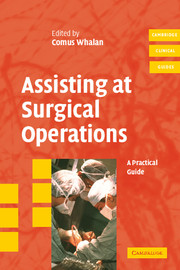Book contents
- Frontmatter
- Contents
- Contributors
- Foreword
- Preface
- PART I Introduction to the operating theatre
- PART II The operation itself
- 5 Preparing for the operation
- 6 General intra–operative principles
- 7 General stages common to operations
- 8 Sterility and the ‘sterile zone’
- 9 Tissue planes: traction and counter-traction
- 10 Surgical instruments: their names and how to use them
- PART III Assisting at special types of surgery
- PART IV Immediately after the operation
- Glossary
- Suggested further reading
- References
- Index
5 - Preparing for the operation
Published online by Cambridge University Press: 18 December 2009
- Frontmatter
- Contents
- Contributors
- Foreword
- Preface
- PART I Introduction to the operating theatre
- PART II The operation itself
- 5 Preparing for the operation
- 6 General intra–operative principles
- 7 General stages common to operations
- 8 Sterility and the ‘sterile zone’
- 9 Tissue planes: traction and counter-traction
- 10 Surgical instruments: their names and how to use them
- PART III Assisting at special types of surgery
- PART IV Immediately after the operation
- Glossary
- Suggested further reading
- References
- Index
Summary
Whenever possible, try to read up in advance about the operation you will be assisting at (see also ‘Key points’, p. 34). Familiarise yourself with the patient. Try to ensure you understand the key points about the patient, the pathology and the proposed operation. What is the disease? Where is it? What symptoms has the patient had? What examination findings? What complications? What investigations? What other medical problems are there? In particular, are there any medical problems that may have an important effect on the surgery? For example, is the patient on warfarin? In an ideal world, you would read the case–notes as well as taking a thorough history and examining the patient yourself. Unfortunately, we live in a world that is often far from ideal, so you will often not have time to do this fully. Under these circumstances, it is probably better to spend more time with the patient, and only use the case–notes to clarify any points that your history and examination do not reveal.
If the pathology may be difficult to identify once the patient is anaesthetised, ensure it is clear beforehand, and the consent form is correct. This particularly applies to ‘sided’ operations (e.g. inguinal hernias, joint replacements), but also to some others where the pathology can disappear from view when the patient lies down (e.g. midline incisional hernias, varicose veins). It is often very helpful simply to ask the patient where he or she expects the operation site to be. Marking the site of the pathology with a skin–marking pen is also a wise safeguard in the above circumstances. This mark is often simply an arrow drawn pointing to the correct surgical site.
- Type
- Chapter
- Information
- Assisting at Surgical OperationsA Practical Guide, pp. 21 - 23Publisher: Cambridge University PressPrint publication year: 2006

